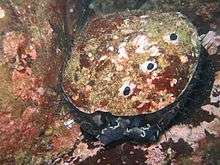Del Mar Landing State Marine Reserve
Del Mar Landing State Marine Reserve (SMR) is a marine protected area that lies onshore, about two miles (3 km) south of the town of Gualala and three and a half miles north of Sea Ranch in Sonoma County on California’s north central coast. The marine protected area covers 0.22 square miles (0.57 km2). Del Mar Landing SMR prohibits the take of all living marine resources.

History
Del Mar Landing SMR is one of 22 marine protected areas adopted by the California Department of Fish and Game in August 2009, during the second phase of the Marine Life Protection Act Initiative. The MLPAI is a collaborative public process to create a statewide network of protected areas along California’s coastline.
The north central coast’s new marine protected areas were designed by local divers, fishermen,conservationists and scientists who comprised the North Central Coast Regional Stakeholder Group. Their job was to design a network of protected areas that would preserve sensitive sea life and habitats while enhancing recreation, study and education opportunities.
The north central coast marine protected areas took effect May 1, 2010.
Geography and natural features
Del Mar Landing SMR lies onshore, about two miles (3 km) south of the town of Gualala and three and a half miles north of Sea Ranch in Sonoma County on California’s north central coast.
This SMR modifies the pre-existing Del Mar Ecological Reserve, an MPA valued by local communities.
The Del Mar Landing SMR is bounded by the mean high tide line and straight lines connecting the following points in the order listed:
- 38°44.7′N 123°31.0′W / 38.7450°N 123.5167°W
- 38°44.2′N 123°31.0′W / 38.7367°N 123.5167°W
- 38°44.2′N 123°30.3′W / 38.7367°N 123.5050°W and
- 38°44.43′N 123°30.3′W / 38.74050°N 123.5050°W.
Habitat and wildlife
Del Mar Landing SMR modifies the pre-existing Del Mar Ecological Reserve, an MPA valued by local communities, to better protect nearshore finfish and abalone and their habitat.
Recreation
Abalone diving, ocean and freshwater fishing, swimming and kayaking take place in the area. Visitors to the area can camp at Gualala River Redwood Park, Gualala Point Regional Park and Anchor Bay Campground. Collecting living marine resources is prohibited due to the Marine Life Protection Act.[1] Activities such as kayaking, diving, snorkeling, and swimming are allowed unless otherwise restricted.
Scientific monitoring
As specified by the Marine Life Protection Act, select marine protected areas along California’s central coast are being monitored by scientists to track their effectiveness and learn more about ocean health. Similar studies in marine protected areas located off of the Santa Barbara Channel Islands have already detected gradual improvements in fish size and number.[2]
References
- ↑ Department of Fish and Game. "California Fish and Game Code section 2853 (b)(3)". Marine Life Protection Act. Retrieved December 18, 2008.
- ↑ Castell, Jenn, et al. "How do patterns of abundance and size structure differ between fished and unfished waters in the Channel Islands? Results from SCUBA surveys". Partnership for Interdisciplinary Studies of Coastal Oceans (PISCO) at University of California, Santa Barbara and University of California, Santa Cruz; Channel Islands National Park. Retrieved December 18, 2008.